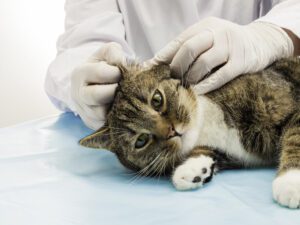Fortunately, ear problems are pretty uncommon in cats, but they can suffer from afflictions such as ear mites (also known as otodectes cynotis). Second only to fleas, ear mites are the most common parasite to affect felines. The mites do not fly or hop, but they can crawl. If they are on your cat’s belly or back, they can be groomed away and swallowed.
But if they are somewhere else on the body that can’t easily be reached
Ear mites are most common among outdoor cats, but indoor cats exposed to other animals can also be at risk. Find out more about cat mites and how to treat them by reading our Webster, TX, animal hospital‘s article below.
Signs to Lookout For
External
Aside from inflammation in your cat’s outer ear, you should also bring your cat to the vet if you notice them exhibiting any of the following behaviors:
- Holding their ears flat against their head
- Relentlessly scratching its ears
- Shaking its head frequently—as if trying to dislodge something out of its ears
Internal
Although ear mites themselves are said to be the size of a pinhead, and they may be visible to the naked eye, they make themselves visible inside your cat’s ears through their creation of a dark, gooey, and foul-smelling mixture of debris and wax. A red rash can also develop inside of the ear.
Testing
A veterinarian can diagnose your cat with ear mites by using an otoscope, a flashlight-like instrument that can reach the depths of its ears. It magnifies the mites so that they can be seen moving around. Eggs may also be seen. Cats intolerable of this procedure can be tested by using a cotton swab to collect debris for microscopic examination. Under a microscope, mites look spider-like with eight legs.
If a cat’s ears are particularly sore, they may need to be sedated in order for a proper examination to be done.
Treatment
Once a diagnosis is confirmed, your vet will begin by thoroughly cleaning your cat’s ears from any residue that may shield the mites and then recommend the proper insecticidal product. The medication is targeted at killing adult mites and larval forms, as it cannot penetrate eggs or pupae (an insect in its inactive form between larva and adult).
Treatment options include daily topical or oral medications and injections. Ivermectin (an antiparasitic) is noted as highly effective in these forms. Our Webster, TX, veterinarian recommends using Revolution Topical Solution.
However, it is not advised for you try any method of treatment without first consulting with your veterinarian, and whatever medication your vet prescribes or recommends will be based on your cat’s condition and your specific situation and preference.
Note that there are no products that can be used around your home or directly on your animal’s skin (aside from inside and around the ear). However, similar products for flea control can be effective for those purposes.
As mentioned above, ear mites are highly contagious, and they can be transferred between species, so all of your animals may need to be treated (even if they are not showing symptoms). This will reduce the risk of recurrence and spread of the disease.
Early intervention of ear mites is essential in preserving the cat’s health, comfort, and appearance—scarring and other mutilations that result from aggressive scratching. Untreated ear mites may also lead to a serious ear disease, called otitis externa, which is an infection of the outer ear that can progress into the middle and inner ear. It can cause permanent damage to an animal’s sense of hearing and balance.
A vet will likely request to see the animal even after treatment is complete (usually after at least three weeks) in order to make sure the infection has been eradicated.
It’s important for you to follow your vet’s advice and follow through with ALL treatment plans, even after it appears that the symptoms have started to resolve—as mites at different stages of the life cycle may survive until the end of the treatment.
Transfer to Humans
Unlike the transfer between animals, the transfer of ear mites to humans is rare. Rare, but also possible. Susceptible people may develop a temporary and itchy rash on their skin. The presence of which should go away after the infected animal is properly treated.
Reach Out to Our Webster, TX, Animal Hospital for Treatment of Your Cat’s Ear Mites
Ear mites, although more common among outdoor cats, can still affect felines that reside indoors, and they are highly contagious (and not specific to different species). Cat owners should be on the lookout for aggressive and relentless scratching, head tilting and shaking, outer inflammation, and internal dark discharge (which may resemble coffee grounds).
Early detection and treatment, in the form of topical, oral, or injectable medication) is integral in promoting your cat’s health and quality of life.
To schedule your cat’s ear mite exam, give our Webster, TX, veterinary team a call at (281) 486-1509.
*-A VMD is the same degree as a Doctor of Veterinary Medicine (DVM), but it stands for the Latin terminology, Veterinariae Medicinae Doctoris.

